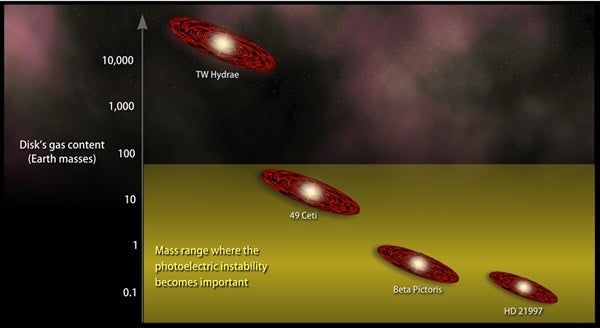But a new study by NASA scientists sounds a cautionary note in interpreting rings and spiral arms as signposts for new planets. Thanks to interactions between gas and dust, a debris disk may, under the right conditions, produce narrow rings on its own, no planets needed.
“When the mass of gas is roughly equal to the mass of dust, the two interact in a way that leads to clumping in the dust and the formation of patterns,” said Wladimir Lyra at NASA’s Jet Propulsion Laboratory in Pasadena, California. “In essence, the gas shepherds the dust into the kinds of structures we would expect to see if a planet were present.”
The warm dust in debris disks is easy to detect at infrared wavelengths, but estimating the gas content of disks is a much greater challenge. As a result, theoretical studies tend to focus on the role of dust and ice particles, paying relatively little attention to the gas component. Yet icy grains evaporate and collisions produce both gas and dust, so at some level all debris disks must contain some amount of gas.
“All we need to produce narrow rings and other structures in our models of debris disks is a bit of gas, too little for us to detect today in most actual systems,” said Marc Kuchner at NASA’s Goddard Space Flight Center in Greenbelt, Maryland.
Here’s how it works. When high-energy ultraviolet light from the central star strikes a clump of dust and ice grains, it drives electrons off the particles. These high-speed electrons then collide with and heat nearby gas.
The rising gas pressure changes the drag force on the orbiting dust, causing the clump to grow and better heat the gas. This interaction, which the astronomers refer to as the photoelectric instability, continues to cascade. Clumps grow into arcs, rings, and oval features in tens of thousands of years, a relatively short time compared to other forces at work in a young solar system.
A model developed by Lyra and Kuchner shows the process at work.
“We were fascinated to watch this structure form in the simulations,” Lyra said. “Some of the rings begin to oscillate, and at any moment they have the offset appearance of dust rings we see around many stars, such as Fomalhaut.”
In addition, dense clumps with many times the dust density elsewhere in the disk also form during the simulation. When a clump in a ring grows too dense, the ring breaks into arcs, and these arcs gradually shrink until only a single compact clump remains. In actual debris disks, some of these dense clumps could reflect enough light to be directly observable.
“We would detect these clumps as bright moving sources of light, which is just what we’re looking for when we search for planets,” said Kuchner.
The researchers concluded that the photoelectric instability provides a simple and plausible explanation for many of the features found in debris disks, making the job of planet-hunting astronomers just a little bit harder.










